The NX Nail System
Overview
Designed in collaboration with renowned US orthopaedic hand surgeons from leading hospital training institutions, NX Nail has a partially threaded design with a wide head, narrow waist, and smooth shaft.
Primary stability is achieved by the interference fit of the compaction taper head, which, when combined with distal fragment control from the leading tip, provides rotational and longitudinal control without compression. In addition, an extensive size range made from biocompatible titanium alloy (Ti-6AI-4V ELI) offers surgeons flexibility to treat a variety of patient anatomies.
Available as a traditional reusable system with non-sterile implants and instruments or as a fully sterile system with single-use instruments and individually packed implants (US Only), the NX Nail system can meet your needs.
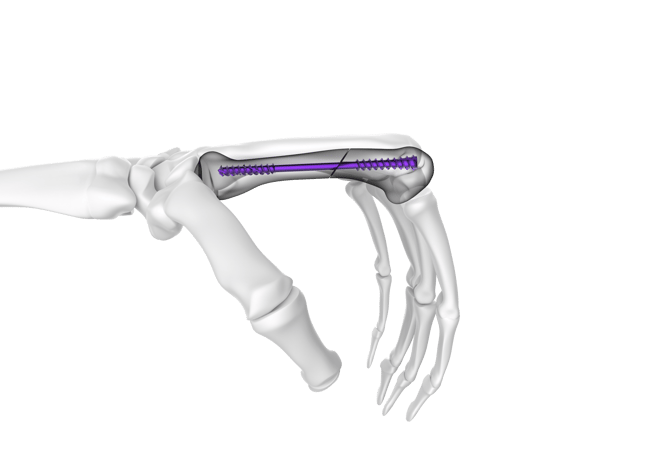
Compaction Taper Head
- Designed from statistical shape models of real CT scans to be anatomically contoured and maximise engagement.
- Engineered to circumferentially displace and compact cancellous bone to increase relative density and load the bone.
- Strong fixation generated by interference fit between implant threads and bone for rotational control and longitudinal stability.
- Features a constant screw pitch for controlled advancement.
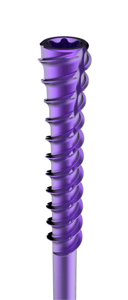
Smooth Shaft
- Facilitates passage through the isthmus and respects the viscoelastic properties of bone with no diaphyseal fixation or stuffing.
- No reaming or cortical contact reduces endosteal irritation and disruption to blood supply.
Precision Leading Tip
- Designed for ultra-low insertion torque with a high precision, multi-start, self-cutting design.
- Fine thread pitch provides distal fragment control and a constant screw pitch allows for controlled advancement.
Titanium Alloy
- Made from a biocompatible Ti-6Al-4V ELI that avoids common metal allergies and is resistant to corrosion.
- Provides strength and facilitates a large size range.
- Has a modulus closer to bone than other medical grade alloys.
Non-Compressive Design
- Matching thread pitch on the head and tip provide a neutral compression profile.
- Embodies the AO principles of relative stability1 and maintains length, restores version, and controls angulation while bridging the fracture and controlling micromotion for indirect healing and callus formation.2,3,4
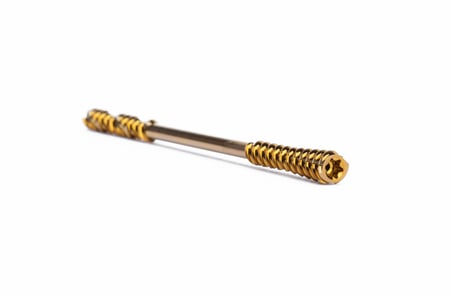
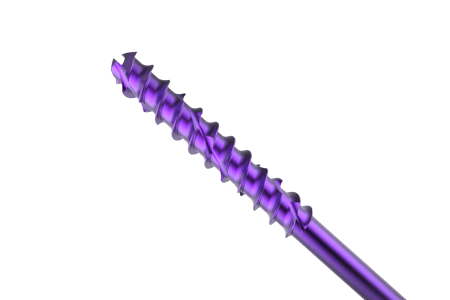
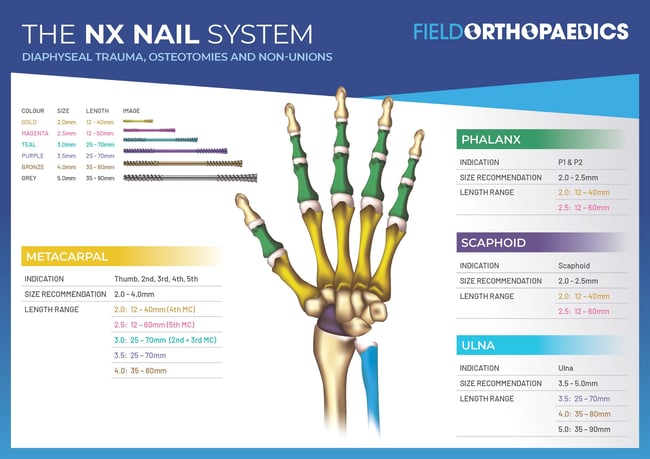
Benefits
The NX Nail provides rigid fixation, stability and an environment for bone healing which accelerates return to function and mobility.1,4
With a minimally invasive surgical approach that avoids extensive soft-tissue dissection and no hardware profile, NX Nail is suitable for high-demand patients requiring a short recovery before returning to work and daily activities.1,4,5
NX Nail offers a reliable alternative to K-wires and plates with minimal complications and a short learning curve.6 A minimally invasive surgical approach avoids extensive softtissue dissection6 while buried hardware avoids adhesions.7

What are the risks associated intramedullary nailing?
Contraindications, potential complications, warnings and precautions:
In any surgical procedure, the potential for complications and adverse reactions exists. Contraindications include cases of inflammation, cases of active or suspected sepsis / infection and osteomyelitis, patients with certain metabolic diseases and applications that are not defined by the indications.
The risks and complications with these implants can include loosening, deformation or fracture of the implant, acute post-operative wound infections and late infections with possible sepsis, thrombosis and embolism, wound hematoma and delayed wound healing, temporary and protracted functional neurological perturbation, tissue reactions resulting from allergy or foreign body reaction to dislodged particles and corrosion with localised tissue reaction and pain. All complications listed here are not typical of the Field Orthopaedics (FO) Bony Trauma Extremity System (BTES) but can be in principle observed with any implant.
Warnings and precautions related to the use of the FO BTES include; re-operation to remove or replace implants may be required at any time due to medical reasons or device failure, if corrective action is not taken complications may occur; use of an undersized screw/nail in areas of high functional stresses may lead to implant fracture and failure; plates and screws, wires, or other appliances of dissimilar metals should not be used together in or near the implant site; the FO Screws, NX Nails, Plates, Pins and K-Wires, and FO drill bits are intended for single use only, re-use may cause product failure and could lead to disease transmission; instruments, guide wires and screws/nails are to be treated as sharps; Field Orthopaedics branded instrumentation is recommended for use in conjunction with FO BTES Implants.
These devices have not been evaluated for safety and compatibility in the MR environment. For further details, please consult the instructions for use.
Case Reports
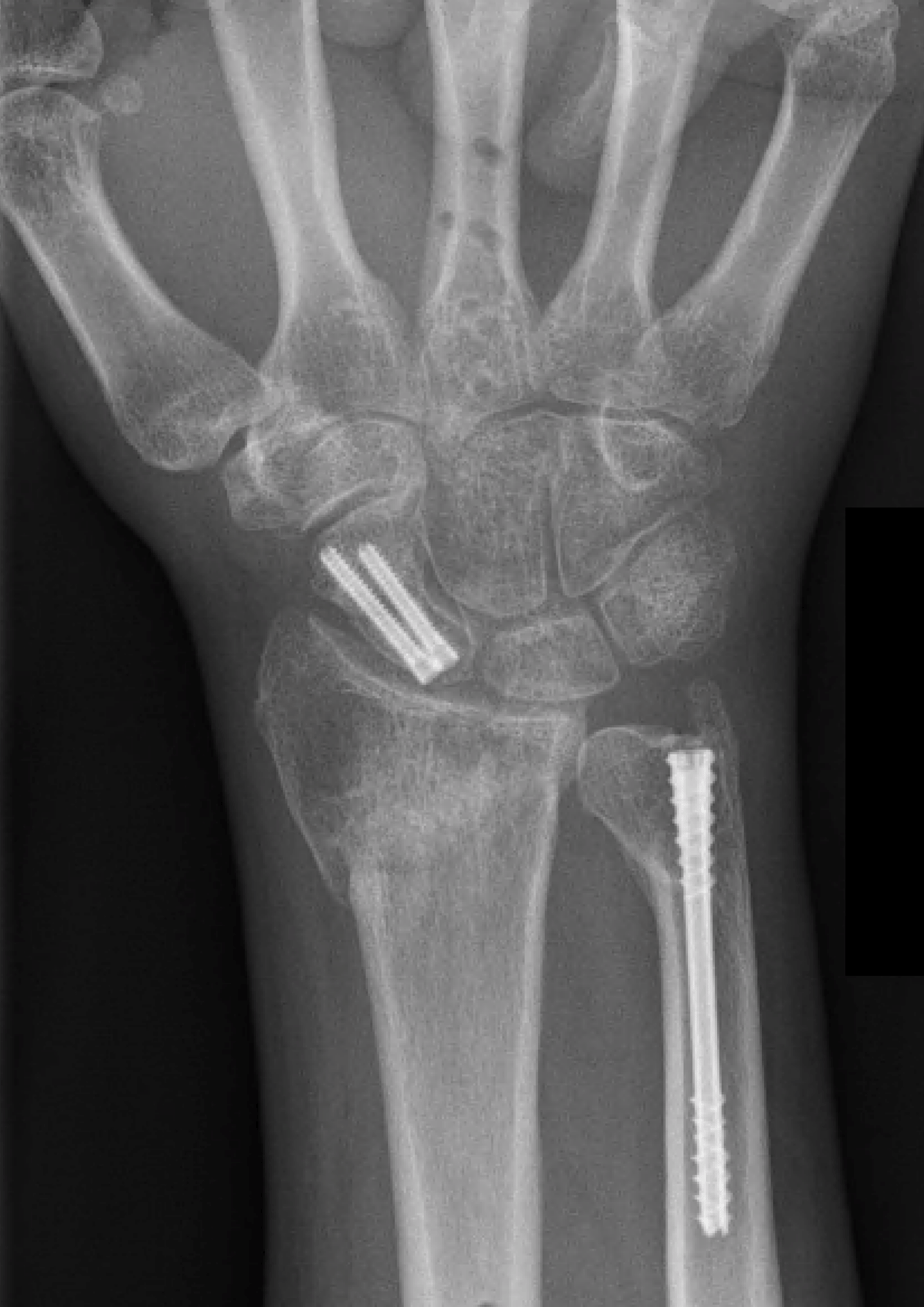
Using NX Nail for a distal ulna fracture in a high energy wrist injury.
A 25-year-old right-hand-dominant male presented with a high energy injury to the right wrist after a motorcycle accident. X-rays showed fractures of the distal radius, distal ulna, scaphoid and hook of hamate. The patient was treated with a combination of the Field Orthopaedics 4.0mm NX Extremity Nail to provide fixation to the distal ulna, a dorsal bridge plate to temporarily stabilize and maintain the length of the distal radius and parallel headless compression screws with bone graft for the scaphoid waist fracture.
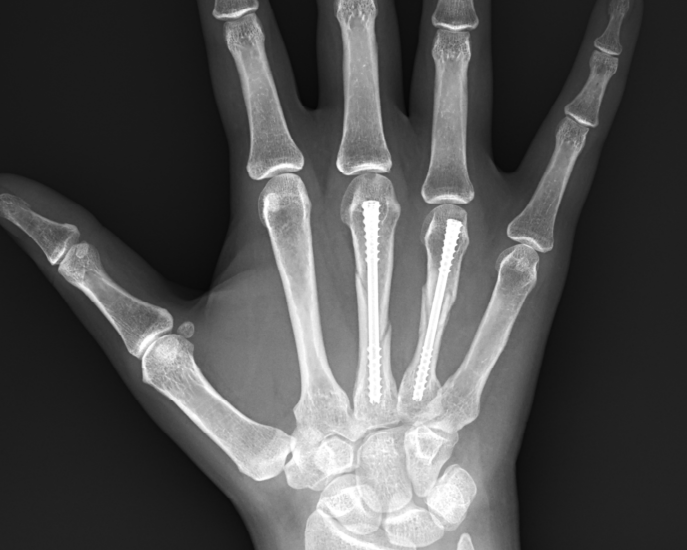
Using NX Nail for unstable fractures of the 3rd & 4th metacarpals.
A 25-year-old right-hand-dominant female presented to Dr Wurapa three days after being involved in a motor vehicle accident. X-rays showed unstable fracture patterns involving the third and fourth metacarpal shafts. Given her young age, dominant hand involvement and fracture patterns; reduction and fixation was recommended and achieved with the NX Nail.
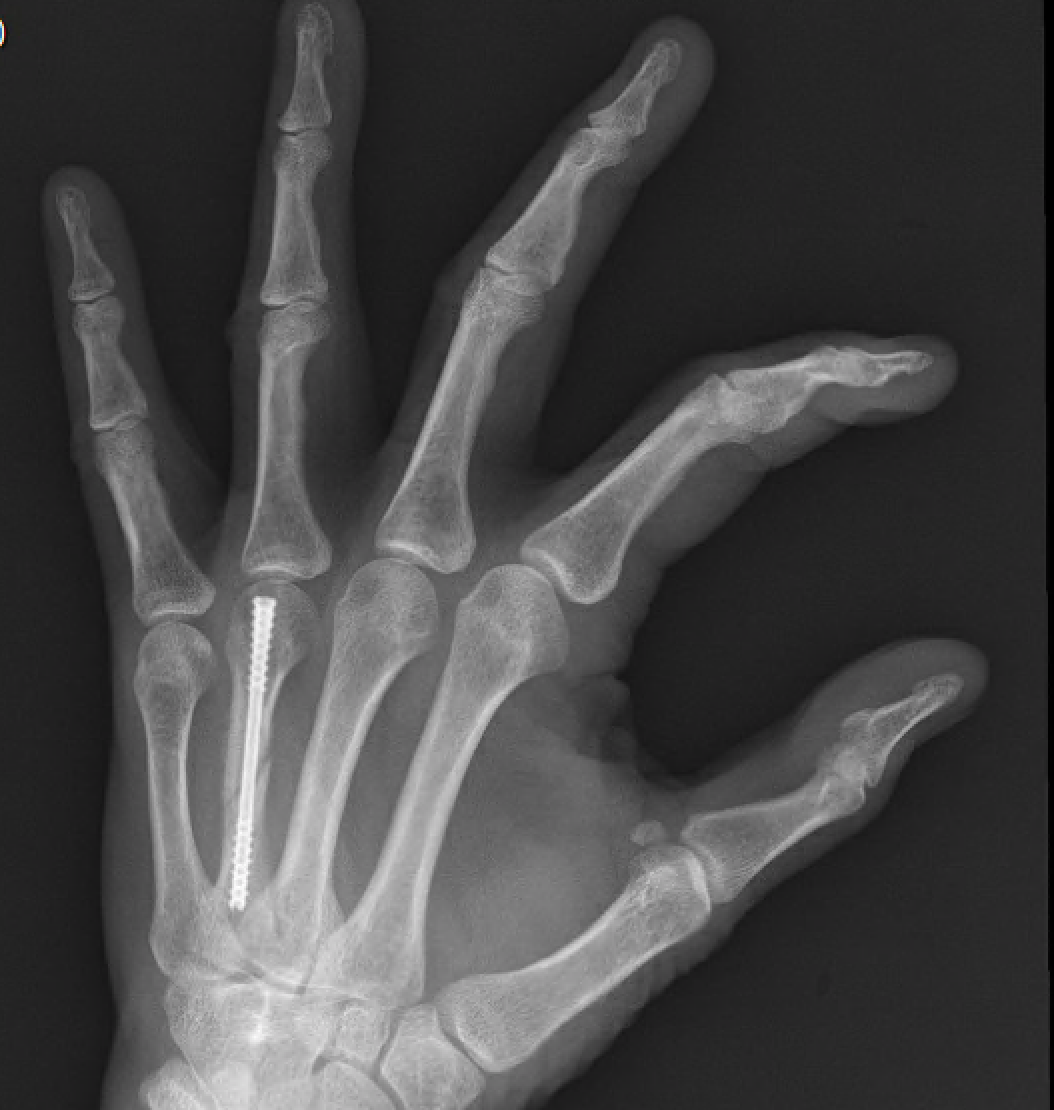
Using NX Nail for fixation of a spiral fracture of the 4th metacarpal.
A 56-year-old female presented to Dr Grier after sustaining an injury to her left hand while riding an E-bike. Radiographs confirmed a spiral fracture of the fourth metacarpal diaphysis with displacement in both the coronal and sagittal planes. With a desire to return to her active lifestyle and a concerning degree of malrotation present, the decision was made to stabilise the fracture with an NX Nail from Field Orthopaedics. At follow-up the patient demonstrated full active range of motion of the ring finger, was able to make a fist and had all motor function intact. With preserved implant alignment and no evidence of hardware failure, the patient was able to resume normal function without restriction.
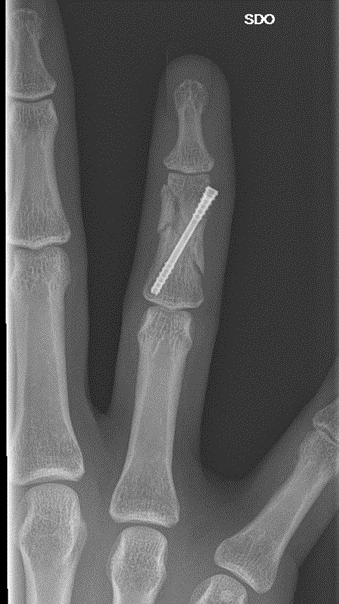
Using NX Nail for a comminuted P2 phalanx fracture.
A 20-year-old female professional Australian Football League (AFLW) player suffered an injury to the ring finger of her dominant right hand in a collision at training. She was seen by Dr Couzens the next day and presented with pain, swelling and an angulated finger. Radiographs showed a comminuted fracture of the middle P2 phalanx. Dr Couzens achieved definitive fixation with a 2.0mm x 22mm NX Nail through a percutaneous approach. The operative finger was buddied to the middle finger initially and the patient was seen by a hand therapist for provision of a training and playing splint. By six weeks she was cleared to return to contact ball work with no restrictions in the gym. In this instance, Dr Couzens was able to treat a painful and debilitating injury for a young patient whose vocation requires the full use of her hand and fingers.
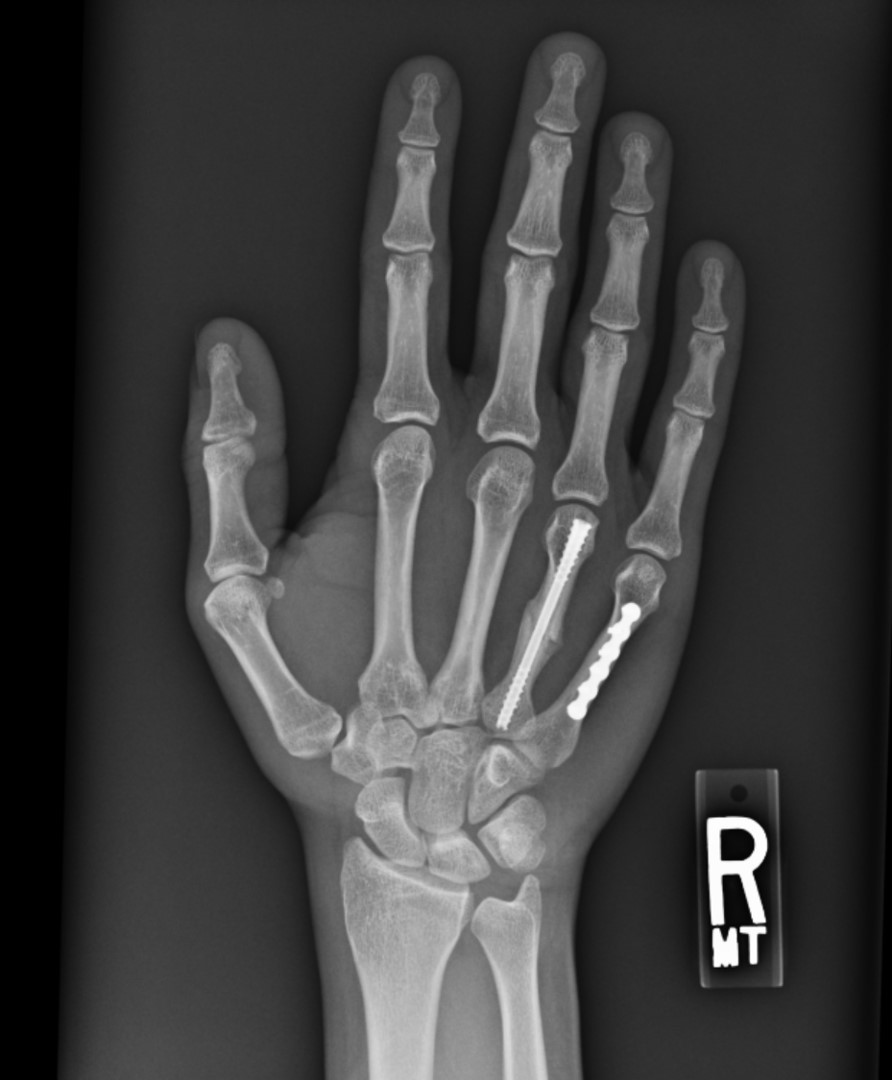
Using NX Nail for fixation of a displaced fourth metacarpal shaft fracture.
A 25-year-old male presented to the local emergency department for treatment of a painful and swollen right hand after a fall. Upon review by Dr Wurapa six days later, radiographs revealed a displaced shaft fracture of the fourth metacarpal. Incidentally, there was a small plate present on the fifth metacarpal in the same hand from a prior remote injury. With the patient adamant to avoid the painful and prolonged recovery he had previously experienced, Dr Wurapa opted for a 3.5mm diameter, 50mm length NX Nail to provide definitive fixation. Six days postoperatively the patient had good hand motion and was given a splint to aid in his return to work. By eight weeks he reported no pain or functional limitations. In this case, Dr Wurapa was able to treat a young patient who was keen to return to work with a superior alternative to plate fixation.
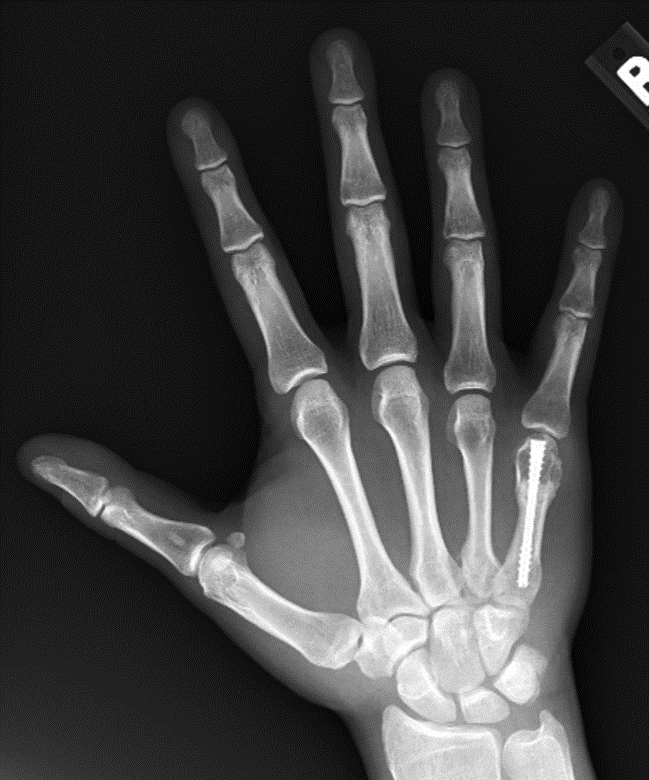
Using NX Nail for fixation of a fifth metacarpal fracture involving the distal diaphysis with comminution.
A 37-year-old male sustained a crush injury to his non-dominant hand at work. He was initially evaluated at a local emergency department before presenting to Dr Wurapa three days later. Upon evaluation, he had a dorsal laceration and a fifth metacarpal fracture of the right hand which involved the distal diaphysis with comminution. After discussing operative and nonoperative treatment options for the fracture, the patient elected to proceed with open reduction internal fixation to minimize limitations during his recovery and return to work. Dr Wurapa achieved definitive fixation with a 4.0mm diameter, 45mm length NX Nail following debridement and repair of the dorsal wound. By four weeks post-operatively the patient reported no pain, had weaned splint use, and returned to normal daily activities and work tasks with full digital motion. At his final appointment he was deemed to have completed a full clinical recovery with solid consolidation at the fracture site. In this case, the NX Nail offered Dr Wurapa a solution for treating a complex fracture while maintaining length, restoring version, and controlling angulation1 .
References
- AO Foundation. Basic principles of intermedullary nailing. AO Surgery Reference. [Online] https://surgeryreference.aofoundation.org/ Orthopaedic-trauma/ adult-trauma/basic-technique/basic-principles-of-im-nailing#nail-removal.
- Kodi Kojima and Robinson E Piers, Absolute and relative stabilities for fracture fixation: the concept revisited, October 2017, Injury, 48(2):S1
- Josefa Bizzarro and Pietro Ragazzoni. Four Principles of Fracture Mangement. Lecture. AO Foundation. AO Trauma.
- M.E. Müller, M. Allgöwer, R. Schneider, and R. Willenegger: AO Manual of Internal Fixation, 3rd Edition. Berlin: Springer-Verlag. 1991.
- Rafael Diaz-Garcia, Jennifer F Walijee. Current Management of Metacarpal Fractures. Hand Clinic, November 2013, 29(4), pp. 507-518.
- Marco Guidi, Florian S Frueh, Inga Besmens, Maurizio Calcagni. Intramedullary compression screw fixation of metacarpal and phalangeal fractures. October 2020. EFORT Open Reviews, 5, 624-629.
- Michael Okoli, Rishi Chatterji, Asif Ilyas, William Kirkpatrick, Jack Abboudi, Christopher M Jones. Intramedullary Headless Screw Fixation of Metacarpal Fractures: A Radiographic Analysis for Optimal Screw Choice. 2022. HAND, 17(2), 245-253

